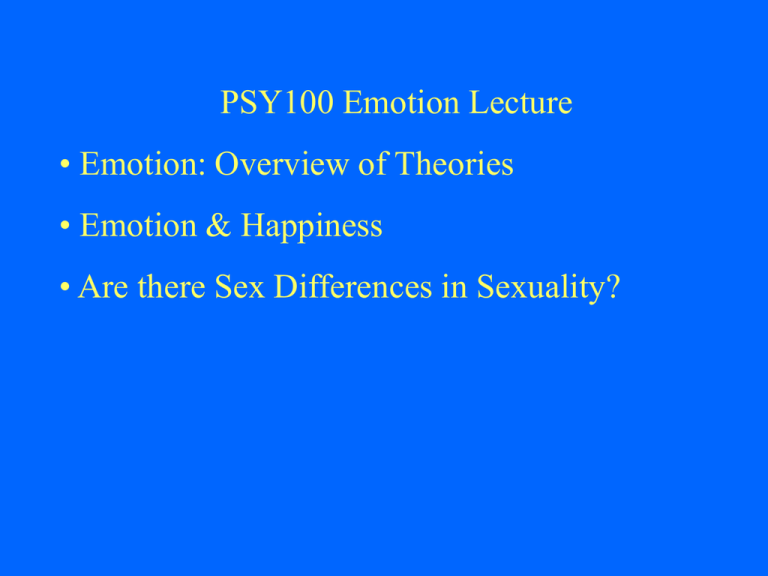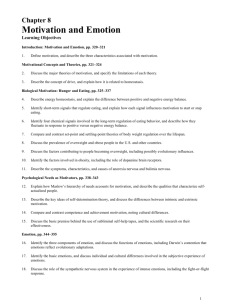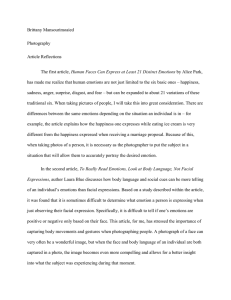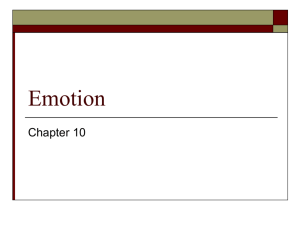
PSY100 Emotion Lecture
• Emotion: Overview of Theories
• Emotion & Happiness
• Are there Sex Differences in Sexuality?
Emotion
What are emotions?
Typical emotions are anger, fear, sadness, and
happiness. These emotions are sometimes called
basic emotions.
Emotions are states that are generated by
evaluations or appraisals of the environment (Is
this event/object good or bad for me?)
Emotions differ from other feelings such as moods
or bodily sensations. These other feelings are not
elicited by appraisals.
Components of Emotions
• Emotions have several components:
• Experiences (I feel …)
• Physiology changes (bodily changes, neurological
processes)
• Behavior and Expression (facial expressions,
actions)
• Although all components are present during
intense emotional experiences, components can
occur without other components.
Physiological Responses
• Older emotion theories (James-Lange theory)
assumed that different emotions have distinct
patterns of physiological responses.
• Evidence shows that most emotions activate the
sympathetic nervous system, leading to increased
heart rate, blood pressure, and skin conductance
(sweaty hands).
• Only sexual arousal has a distinct physiological
response.
Skin conductance and Lie-Detection
• The skin conductance response is used for liedetection.
• However, it does not reflect lying.
• Rather, skin conductance is activated by relevant
stimuli.
• For example, if the murder weapon is a knife,
skin conductance will increase more in response to
the word knife than to other potential weapons
(gun, ax, poison).
• This is true, even when people tell the truth.
Emotion in the Brain
• One area of the brain that is frequently linked to
emotion is the amygdala (see textbook for picture).
• Animal studies suggest that the amygdala is
particularly responsive to threatening stimuli.
• However, in recent years it has become possible
to study activity in the amygdala of human
participants while watching emotional pictures.
• These studies show that the amygdala is activated
by both negative (angry faces) and positive
(erotica) stimuli.
Mood and the Brain
• Moods are pleasant and unpleasant states that are
not directly related to events.
• Tremendous progress has been made in
understanding the biological processes underlying
moods.
• Many legal (Prozac) and illegal (ecstasy) drugs
influence moods because they influence the
communication between neurons by increasing the
amount of neurotransmitters (serotonine,
dopamine).
Prozac and Ecstasy
• Although Prozac and Ecstasy both influence
serotonine, they do so differently.
• Prozac helps to keep normal amounts of
serotonine available for a longer time.
• Ecstasy releases abnormally high levels of
serotonine and depletes neurons of serotonine.
Facial Expressions and Emotions
• Darwin already postulated a set of universal facial
expressions.
• Research over the past decades confirmed that six
emotions are associated with distinct facial
expressions, which are more or less universally
recognized across different cultures.
• Let’s see whether you can identify the correct
emotion based on facial expressions.
The six emotions that are well recognized in facial
expressions are:
Happiness
Surprise
Fear
Anger
Sadness
Disgust
Facial-Feedback Theories
• Facial-feedback theories assume that facial
expressions are closely related to other
components of emotions.
• Indeed, the theories assume that feedback from
the facial muscles generates emotional
experiences.
• That is, you feel happy because you smile rather
than you smile because you feel happy.
• Although popular for many years, empirical
support for facial-feedback theories is weak.
Peripheral versus Central Theories of Emotions
• Facial feedback-theories are a special case of
theories, which assume that emotional experiences
are based on feedback from peripheral
physiological changes (James-Lange theory,
Schacter and Singer)
• However, evidence for these theories is also
weak. Most researchers assume that emotional
experiences are directly generated in the brain.
• Sometimes peripheral feedback may intensify
emotional experiences.
Cognitive Theories of Emotions
• Cognitive theories of emotions assume that
emotions are elicited by appraisals of the
environment.
• Cognitive theories explain why the same event
(e..g, getting a B in an exam) can lead to different
emotions.
• For some students getting a “B” will exceed
expectations, leading to happiness. For other
students, a B will be below expectations, leading to
negative emotions (disappointment, sadness,
anger).
Person-Situation Interaction
• One important implication of cognitive theories is
that we need information about the situation and
the person to predict an emotional response.
• For example, to predict fear-responses to snakes
and spiders, we need to know whether the stimulus
is a snake or a spider, and whether an individual is
spider-phobic or snake-phobic.
• Different situations make different people feel
good or bad.
Emotion and Happiness
• Emotion research has important implications for
our happiness.
• Over the past 20 yeas, Ed Diener and colleagues
have studied the factors that make some people
happier than others.
• I have worked in Ed Diener’s laboratory for 2
years and I have published several articles with Ed
Diener on this important topic.
Scientific Definition of Happiness
• Scientists like Ed Diener think that the term
happiness is too ambiguous for scientific research.
• They prefer to call happiness subjective wellbeing.
• Subjective well-being has two components:
- a cognitive component
- an affective (emotional) component
Cognitive Component of SWB
Life-Satisfaction
1. In most ways my life is close to ideal.
2. The conditions of my life are excellent.
3. I am satisfied with my life.
4. So far I have gotten the important things I want
in my life.
5. If I could live my life over, I would change
almost nothing.
Do you recognize these items?
Life-Satisfaction around the World
(Diener and colleagues’ 2001 survey)
Happy Nations
Canada
Switzerland
Netherlands
USA
Germany
UTM-2000
UTM-2002
Not so Happy Nations
28.0
27.2
24.7
24.4
24.4
24.1
23.5
Uganda
China
Cameroon
Egypt
Georgia
Nepal
Japan
S.Korea
15.5
16.0
17.2
18.0
18.5
18.9
19.2
20.0
The Affective Component
Amount of Positive and Negative Feelings
• Positive Affect: How often do you feel happy,
cheerful, joy, pride, etc.
• Negative Affect: How often do you feel unhappy,
sad, down, tense, etc.
• Hedonic Balance: Positive Affect – Negative
Affect.
• “Happiness” is to experience a lot of Positive
Emotions and few Negative Emotions.
Hedonic Balance around the World
(Diener and colleagues’ 2001 survey)
Canada
Switzerland
Netherlands
USA
Germany
3.27
2.47
2.17
2.17
2.00
Uganda
China
Cameroon
Egypt
Georgia
Nepal
Japan
S.Korea
1.54
1.17
1.82
1.22
1.63
1.55
0.58
1.70
UTM data are not comparable because I used a
different scale to measure hedonic balance.
• Affective and Cognitive Well-Being are related.
• Countries with high satisfaction also tend to
have high hedonic-balance.
• Countries with low satisfaction also tend to
have low hedonic balance.
• This fact can be captured in a correlation: Lifesatisfaction and hedonic balance are highly
correlated (r = .68).
Why are cognitive and affective well-being
related?
Why are they not identical?
These questions were examined in an article by
Schimmack, Diener, and Oishi (2002).
• Students completed the five-item SWLS.
• Afterwards they answered questions about the
information that they used to answer the SLWS
items.
• For example…
Yes/No
• Did you think about the weather?
• Did you think about your past emotions?
What do students think about to answer lifesatisfaction judgments?
Academic Performance
89%
Romantic Relationship
82%
Family Relationships
80%
Health
77%
Hedonic Balance
73%
Weather
8%
Fam Sat.
E
.45*
Rom. Sat.
.09
.24*
.12
N
-.44*
-.33*
Hed. Bal.
.24*
.39*
.46*
Life Sat.
.16
Hea. Sat.
C
.23*
Aca. Sat.
.11
.65*
e
.27*
Conclusion
• People rely on their past emotional experiences
to judge life-satisfaction.
• Hedonic Balance is the strongest predictor of
life-satisfaction.
• However, in addition people also consider
satisfaction in important life domains (romantic
satisfaction, academic satisfaction).
• Satisfaction in these domains does not
necessarily increase hedonic balance (e.g.,
studying hard to get good grades).
Sex Differences in Sexuality
This section is based on one of my most popular
lectures in my PSY230 course, “Introduction to
Personality”
Do men on average have more sexual partners than
women?
What does your textbook have to say about this
question?
“Survey inquires about adults’ actual sexual
histories also indicate that men engage in sex with
a larger number of partners than women do, on the
average (Janus & Janus, 1993).
Does this finding provide conclusive evidence that
men have more sexual partners than women?
2
Stephen
Valerie
5
2
Mark
Tracy
1
2
Matthew
Lily
3
2
Kevin
Barbara
1
Daniel
Shalaine
3
1
Conclusion
• It is logically impossible for men to have more
sexual partners than women.
• Sex differences in the reported number of
partners in surveys must be due to self-report
biases.
• For example, for men it is acceptable or even
desirable to have many partners and they may
provide inflated estimates.
• For women it is less acceptable to have many
partners and they may underestimate.
However, it is still possible that men would like to
have more sex than women.
Are there sex differences in sexual desire?
Many studies suggests that this is the case.
ROP students in my lab conducted a study that
examined this issue during the past semester.
Some of you may actually have participated in this
study.
If not, you still have a chance to sign-up for the
“Emotion and attention study” this semester.
In the study, students had to solve easy math
problems.
They had to compare two single-digit products.
For example, which product is larger?
3 x 5 <> 8 x 6
Left product larger
Right product larger
The math problem was presented in front of
pictures.
Participants had to ignore the pictures.
However, emotionally relevant stimuli
automatically attract attention.
Hence, participants should need more time to
respond when the math problem is presented in
front of an emotional picture.
Question: Would men be more distracted by
pictures of attractive women, than women by
pictures of attractive men?
Study
Participants. 123 women, 62 men.
Materials. Pictures of attractive models.
Difference to neutral pictures (milliseconds)
140
Women
Men
100
60
20
-20
SF
SB
OF
OB
SF = Same-sex face; SB = same-sex face&body
OF = Opposite-sex face; OB = opposite-sex f&b
Conclusion
• Men and women’s attention is automatically
attracted by pictures of attractive members of the
opposite sex.
• The effect is significantly stronger for men than
for women.
• Even pictures of attractive faces produce the
effect, although pictures of attractive faces and
bodies have a stronger effect.
• Women, but not men, also show a slight
tendency to respond to same-sex pictures.
General Conclusion
• Emotions are an important topic of psychological
research.
• Positive and negative feelings (emotions, moods)
are a fundamental component of happiness.
• To help people lead happier lives, psychologists
study the determinants of positive and negative
feelings.
• People respond differently to different situations.
Hence, different situations make different people
happy.









